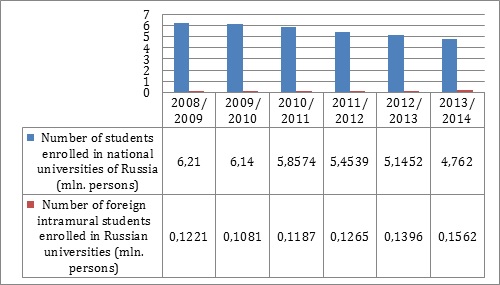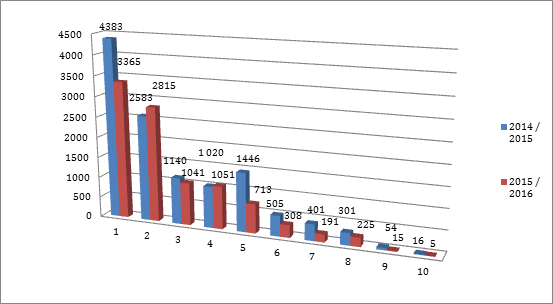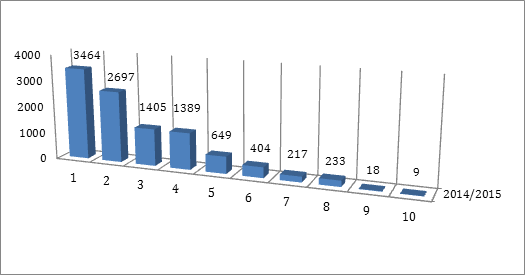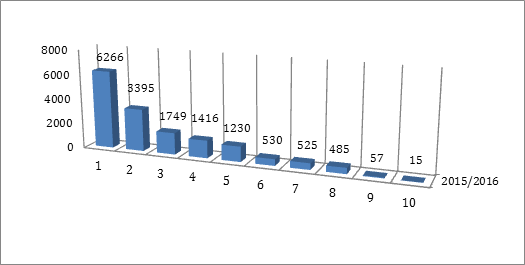Abstract
The transformation of international relations, economics, scientific views, and technologies of production and communication implies the processes of involvement and social and academic integration. Introduction of new international standards for Russian higher education and establishment of the federal project 5/100/2020 to boost the global competitiveness of Russian universities in order to break into the top 100 in the World University Rankings (THE, QS and ARWU) affect the reputation of universities. The paper reports on the place of Russia in the global market for education services, primarily of tertiary level, and on changes in the training of foreigners over the last twenty years. The key indicators of training of foreign students in Russia affecting the position of Russian universities in global rankings have been considered. The paper presents statistical data on the number of quotas for admission of foreigners to study in Russian universities at the expense of the Russian budget and satisfaction of foreign students with living conditions.
Keywords: Wellbeingstudentsquotasthe quality of lifeeducationError! Reference source not found
Introduction
The concept of country competitiveness implies the competition of national education systems, reputations in specific areas of scientific schools, and funding of research universities. Russian higher educational establishments are actively involved in the process of competitiveness. The project 5/100/2020 aimed to improve the competitiveness of Russian universities (Ministry of Education and Science of the Russian Federation, 2014) contributes to the strategy, in which the issues of training of foreign students, international academic mobility, and international education play a crucial role.
The developers of global rankings (THE, QS, ARWU) consider the indicator of training of foreign students (international mobile students) based on the tertiary education programmes to be minor and least significant (usually no more than 2.5–5 points out of a possible 100 for a high number of foreigners in the general student body). The mass personnel training for foreign countries brings the most significant and steady income (financial indicators of the international education market is estimated at $ 150 billion a year) to the universities and national economies.
A number of contemporary international literature sources have been devoted to the development of academic mobility for students and students' wellbeing in foreign countries. In particular, the works of Collins (2012), Hawthorne (2014), Urbanovič et al. (2014) describe the variations of regional transformations during the implementation of academic mobility and consider the internationalization strategy of higher education, and principal advantages and disadvantages of this strategy.
The most noteworthy works of F. Robson et al. (2014), Crawford, & Wang (2014), Govender et al. (2014)consider the current issues of adaptation of foreign students.
Much prominence is given to the adaptation of foreigners studying in Russian universities. The universities are recommended to involve foreign students in cultural events, to acquaint them with regional historical and cultural traditions, and to inform the foreigners about the requirements of immigration laws and responsibilities for the violation.
Organization of training of foreign students in Russian universities
Analysis of the growth rates of foreign student in Russia
The internationalization of modern education enhances its availability and quality, promotes the introduction of innovative methods in higher education and stabilization of international cooperation. Figure
The statistical data show that the percentage of foreigners was about 2% of the total number of students studying in Russian universities in 2008–2009. By 2013–2014, the overall number of foreign students had increased to 3.2%.
The Russian Academy of Sciences (the Institute of Sociology) published the projected number of foreign students to 2030. The projection was based on the assumption that the average rate of annual increase in the number of foreigners studying in Russian universities amounted about 9% for the period from 2003–2004 to 2013–2014 would remain the same up to 2030. Of course, there are some exceptions. For example, in contrast to 2008–2009, the number of foreign students decreased by 12% in 2009–2010. However, in 2010–2011 the total number of foreign students increased by 11%. Note that in the previous and subsequent years the number of foreigners increased annually.

On the basis of this assumption, the number of foreign intramural students enrolled in Russian universities is projected to double by 2017–2018 (218.9 thousand foreigners). By 2029–2030, the total number of foreign intramural students studying in Russian universities is proposed to reach 570 thousand persons.
As noted by Rossotrudnichestvo, educational services of Russian universities must be promoted around the world, the international relation in the sphere of education and science as well as its influence in the humanitarian world must be developed and strengthened.
One of the positive documents affecting the inflow of foreign students in Russian universities is the Russian Federation Government Decree No. 891 dated October 8, 2013 "On Establishing an Education Quota for Foreign Nationals and Stateless Citizens in the Russian Federation".
State scholarship (quota) as one of the factors that affects wellbeing of international students
Increase in the number of quotas helps to "maintain the current level of allied relations with a number of foreign countries" (draft of the executive order prepared by specialized agencies and published on the portal regulations.gov.ru (it is assumed to come into force on January 1, 2016)). According to Rossotrudnichestvo, requests for additional places in Russian Universities have already been made from such countries as Angola, Bangladesh, Brazil, Bulgaria, Burundi, Venezuela, Vietnam, Germany, Zambia, Jordan, Iran, Yemen, Palestine, Serbia, Syria, Somalia, Sudan, Mongolia, South Africa and others. Russian authorities allocated additional means for 2,200 places for students from Asia, 1,200 places for students from Africa, 700 places for citizens of the CIS countries, 500 places to the Middle East, 200 places to Latin America, and 200 additional places to the European Union.
The document does not specify the number of places for each country; however, these data can be obtained from open sources. So, in March 2015, the Chairman of the Foreign Affairs Committee of Federation Council (the former head of Rossotrudnichestvo) said that the majority of places in the current academic year have been allocated to Vietnam – 795, and this number will increase to one thousand by 2018.
In 2016, the Russian government will cover the costs of fare, tuition, health insurance, accommodation, and even a higher scholarship for a hundred Cuban students. The "Cuban" model of compensation for training expenses using the budget funds will be applied to the citizens of other countries as well. As pointed out by one of the senators, this project is not only educational, but it provides assistance to our friends (http://www.kommersant.ru/doc/2715149).
It is worth mentioning that this "friendly assistance" will cost the treasury money. The total cost of the foreign student admission is difficult to calculate as the expenses are spread across several different expense lines. However, the document prepared by the authorities reports that allocation of 5 thousand additional quotas in 2016 will cost RUB 206 mln, in 2017 – RUB 826 mln, in 2018 – RUB 1.4 bn, and in 2019 – RUB 2 bn.
"Using state quotas and scholarships for foreign students definitely helps to promote the interests of the country that initiates them. There is nothing new in it – similar practice existed in the USSR and exists to this day in leading academic nations," said Sergey Yerofeyev, the deputy rector in charge of international cooperation of the Higher School of Economics. Russia expects to benefit from this loyalty.
Figure
Figures
The CIS countries (Commonwealth of Independent States), Georgia, Abkhazia and South Ossetia;
Asian Countries;
The countries of Africa south of the Sahara;
The countries of Middle East and North Africa;
Eastern European and Balkan countries;
The countries of Latin America;
The countries of Western Europe;
Baltic countries;
The Nordic countries;
The countries of North America and Oceania.

Figure

Interestingly, not all the international regions claimed for the quotas allocated by the Russian Federation in 2014–2015. In fact, the countries of Asia, Middle East and North Africa, and the countries of Africa south of the Sahara received more quotas than Russia allocated to foreigners. All the other countries have not fully benefited from the proposed quotas.
However, the situation has changed dramatically in two recent years. Figure

Comparison of the statistical data on distribution of Russian quotas for foreigners in 2015–2016 with the data presented in Figure
Analysis of the data revealed that the interest of foreigners in studying in Russian universities increased significantly. It is associated not only with the active promotion of Russian universities in the global market for education services and creation of new educational programs in cooperation with leading foreign universities, but also with improvement of living conditions for foreigners, which contribute to high standards of student wellbeing.
Satisfaction of foreign students with living conditions in Russia and plans for the future
The internationalization of higher education in the modern world is no longer the question of willingness or unwillingness, but the urgent need and essential condition for the university survival. Every year Russia becomes more and more popular country for studying among students from around the world. Living expenses are much cheaper in Russia. In addition, economic and physical safety, domestic and cultural conditions of life positively affect the inflow of foreign students in Russian universities.
Students coming to Russia for the first time are delighted not only with a high level of education, but also with the country, its people and culture. They like exotic Russian climate and customs. Foreign students also like to study with Russian students and live together in small but very friendly dorm rooms. Russians and foreigners get along very well with each other, enjoy getting together at each other homes for holidays, share recipes of traditional dishes, help each other with homework, etc.
About 80% of foreign students living in Russia have no household problems or problems with tolerance on the part of the locals. After graduating the university, more than 84.6% of foreign students have the intention to find a job in their native country, 13.6% – in Russia, 1.8% – in other developed countries. According to the statistical data, 10.7% of men and 24.6% of women out of the total number of foreign students plan to stay in Russia.
Russia provides broad facilities to practise a variety of sports on the modern sports ground and stadiums and offers great opportunities to visit sport events and to practise sport in all parts of the world. Everyone has a chance to develop his creative abilities. Students enjoy reduced fares for visiting museums, theatres, cinemas, art galleries, cafes, parks and sports and entertainment complexes, where they can spend time with their friends.
Being in an international environment implies adaptation to each other, and therefore we have to learn all the time. We re-discover our own country and the world around us. We hope that our initiative and the project 5/100/2020 will contribute to the change of consciousness in the society.
Conclusion
Thus, the National Ministry of Education initiates the inflow of foreign students in Russian universities, creating a favourable climate for able students and promoting the integration of science and education. Meeting high standards of internationalization of higher education, which ensure quality, diversity and accessibility of international education, will definitely contribute to the quality of higher education.
Acknowledgements
This work was performed by the author in collaboration with Tomsk Polytechnic University within the project in Evaluation and enhancement of social, economic and emotional wellbeing of older adults under the Agreement No.14.Z50.31.0029
References
- Chernyh, A., Kisrleva, E. (2015, April 24). Russia increases imports of students. The Kommersant. Retrieved from http://www.kommersant.ru/doc/2715149 (in Russian)
- Collins, F. (2014). Globalising higher education in and through urban spaces: Higher education projects, international student mobilities and trans-local connections in Seoul. Asia Pacific Viewpoint, 55, 242–257.
- Collins, F. L. (2012). Researching mobility and emplacement: examining transience and transnationality in international student lives. Area, 44, 296–304.
- Collins, F. L. (2013). Regional Pathways: Transnational Imaginaries, Infrastructures and Implications of student mobility within Asia. Asian and Pacific Migration Journal, 22(4), 475–500.
- Fiona Robson, Gillian Forstera & Lynne Powell. (2014). Participatory learning in residential weekends: benefit or barrier to learning for the international student? Innovations in Education and Teaching International, 53(3), 274-284. doi:
- Hawthorne, L. (2014). Indian Students and the Evolution of the Study-Migration Pathway in Australia. International Migration, 52(2), 3-19. doi:
- Ian Crawford & Zhiqi Wang. (2014). The impact of placements on the academic performance of UK and international students in higher education, Studies in Higher Education, 41(4), 712-733. doi:
- Jolanta Urbanovič, Stephen Wilkins & Jeroen Huisman (2014): Issues and challenges for small countries in attracting and hosting international students: the case of Lithuania, Studies in Higher Education. Studies in Higher Education, 41(3), 491-507. doi:
- P Govender Jeevarathnam, Dayaneethie Veerasamy, Dion T Noel (2014) The Service Quality Experience of International Students: The Case of a Selected Higher Education Institution in South Africa. Mediterranean Journal of Social Sciences, 5(8), 465–473. doi:
- Scheregi, F.E. et al. (2015) The number of students, teaching staff and educational institutions of the Russian Federation. (A forecast for 2020 and an assessment of trends up to 2030). Moscow. The Institute of Sociology of the Russian Academy of Sciences, Social Forecasting and Marketing Center. Retrieved from http://dinsoc.isras.ru/files/File/publ/Prognoz_2015_august_001_288_ispr.pdf (in Russia)
- Urbanovič, J., Wilkins, S., & Huisman, J. (2014). Issues and challenges for small countries in attracting and hosting international students: the case of Lithuania. Studies in Higher Education, 41(3), 491-507 doi:10.1080/03075079.2014.942267
Copyright information

This work is licensed under a Creative Commons Attribution-NonCommercial-NoDerivatives 4.0 International License.
About this article
Publication Date
17 January 2017
Article Doi
eBook ISBN
978-1-80296-018-1
Publisher
Future Academy
Volume
19
Print ISBN (optional)
-
Edition Number
1st Edition
Pages
1-776
Subjects
Social welfare, social services, personal health, public health
Cite this article as:
Plotnikova, . V., Efremova, O. N., Chechet, D. M., Tchaikovskaya, O. N., & Bastida, J. (2017). Wellbeing of foreign students enrolled in Russian universities: Trends in Development. In F. Casati, G. А. Barysheva, & W. Krieger (Eds.), Lifelong Wellbeing in the World - WELLSO 2016, vol 19. European Proceedings of Social and Behavioural Sciences (pp. 540-547). Future Academy. https://doi.org/10.15405/epsbs.2017.01.73

